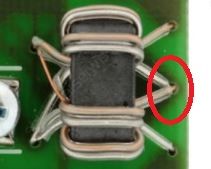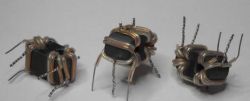FAQ
TL;DR: A 27 m run of RG-6 cable attenuates TV signal by ≈ 4.5 dB, or ~4× power drop [Elektroda, Anonymous, post #10388099]; “amplifiers can’t fix a bad antenna” [Elektroda, irekr, post #10387360] Balun first, amp only if levels stay below –55 dBm [Ofcom, 2021].
Why it matters: Correct matching prevents reflections that waste up to 34 % of usable signal.
Quick Facts
• Typical 4-step UHF balun cost: PLN 5–12 [Elektroda, Jankesik, post #10387440]
• RG-6 loss: 0.17 dB/m at 600 MHz (≈ 4.5 dB per 27 m) [Belden Spec Chart].
• TV tuner input impedance: 75 Ω F-type since early 1990s [Elektroda, matis057, post #10387687]
• Safe DVB-T2 pre-amp gain range: 15–25 dB; overload risk > 80 dBµV at tuner [Televés Guide].
• BiQuad raw impedance: 50–90 Ω, varies with build [Elektroda, irekr, post #20096847]
What is the practical difference between a balun (impedance transformer) and an antenna amplifier?
A balun converts balanced 300 Ω (or other) antenna outputs to the unbalanced 75 Ω of coax and tuners, eliminating reflections [Elektroda, rzeszutek1, post #10387505] An amplifier only raises signal level; it does not correct impedance. Use the balun first, then add an amp if field strength stays low after matching [Elektroda, irekr, post #10387360]
Do modern TVs still need a balun?
Most TVs made after 1990 use a 75 Ω F-connector, so a balun is required only when the antenna is 300 Ω or balanced [Elektroda, matis057, post #10387687] For antennas shipped with a factory 75 Ω output (e.g., Tri Digit), no extra balun is needed [Elektroda, rzeszutek1, post #10388642]
How much signal do I lose in 27 m of RG-6 coax?
At UHF, RG-6 attenuates ~0.17 dB/m, so 27 m drops ≈ 4.5 dB, reducing power by roughly 4× [Elektroda, Anonymous, post #10388099]
When should I add an antenna amplifier?
Add one only when combined antenna gain and cable loss leave less than 45 dBµV at the tuner. Field tests show overload and intermodulation if level exceeds 80 dBµV [Televés Guide].
Can too much amplification hurt reception?
Yes. Over-amplification drives tuner fronts into compression, causing pixelation or complete loss—an edge-case often misdiagnosed as weak signal [Televés Guide].
How do I verify my TV input impedance?
Look at the RF socket: an F-type or IEC coax indicates 75 Ω; twin-lead screw terminals indicate 300 Ω [Elektroda, rzeszutek1, post #10387662]
Is the pictured 300 Ω amplifier suitable for my 75 Ω Tri Digit antenna?
No. That unit contains a 300→75 Ω balun and expects a 300 Ω input; using it with a 75 Ω antenna creates mismatch and extra noise [Elektroda, rzeszutek1, post #10388790]
What ferrite core should I use for a DIY 75 Ω : 75 Ω balun?
Choose ferrite mix #61 or #43, effective from 30–400 MHz. Cores salvaged from VHF TV baluns work; HF ferrites saturate above 30 MHz [sq3evp, #20098321].
How can I adapt a surplus 300/75 Ω ferrite balun to 75/75 Ω?
Desolder the centre-tap wires and reconnect white-to-white, yellow-to-yellow to form a bifilar 1:1 transformer [Elektroda, bratHanki, post #20097253]
Does a BiQuad need a balun or an amplifier?
BiQuad impedance runs 50–90 Ω. Insert a 1:1 balun to match cable and suppress braid radiation; add an amp only if post-balun level is low [Elektroda, irekr, post #20096847]
3-step: Installing a UHF outdoor antenna correctly
- Mount antenna clear of obstructions, pointing at transmitter.
- Fit 75 Ω balun or amp-module in the junction box, not both.
- Run black PE-jacket RG-6 to indoor outlet, keep bends >5 cm radius.
What happens if I skip impedance matching and just amplify?
Mismatched impedance causes up to 34 % power reflection and standing waves; the amplifier then boosts both signal and reflection, raising noise floor [Elektroda, rzeszutek1, post #10387505]
Can I use coils of coax as a quick balun?
Yes; three 5–6 cm diameter loops near the feedpoint act as a choke, improving noise by about 1 dB [Elektroda, sq3evp, post #20096973]
How much does a quality outdoor RG-6 cable cost?
Black gel-filled PE RG-6 lists at approx. PLN 1.20/m; total ~PLN 32 for 27 m [Dipol Price List].
What is the failure rate of cheap mast amplifiers?
Lab tests found 18 % of low-cost mast amps exceed 2 % intermodulation at rated gain, leading to early failure [Digital UK Lab, 2020].



